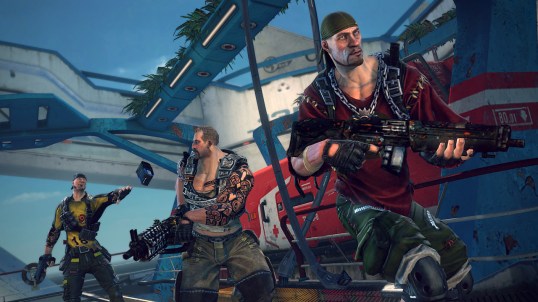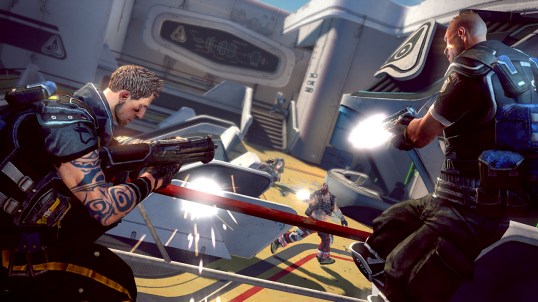While other first-person shooters will be vying for gamers’ thumbs in 2011, no game next year will look like Brink. The characters look lived in, with pockmarks, scars and receding hairlines all among the options for customization. And that customization’s amongst the best I’ve ever seen in any game in recent memory. Sections of the gameworld–a giant ship called the Ark–harbors layers of corroding metal laid over each other in patchwork fashion. Several weeks ago, I spent the better part of a day playing Brink with the folks at Splash Damage in their studio outside of London. I came away very impressed with what’s going into the title. It’s the anti-Halo: scuffed-up, grimy and funky.
Brink‘s got more than just a unique art style to recommend it, though. The game asks what happens when society breaks down and everything’s on the brink of collapse. The Ark begins in the Pacific as an experiment in sustainable community building in 2012 and then, when the sea levels start rising thirteen years later, an influx of refugees from mainlands and island atolls stream in. Players pick up the action in 2045, when the once-glorious Ark’s lost contact with the outside world, becoming overpopulated withthe ugly divide between haves and have-not threatens to explode chaos. On one side is the Resistance, dissidents who distrust the elites secreted away in the spires of the arc. Their goal is to escape the Ark. Their opposition is the Security, who are trying to quell the rebellion sparked by the Resistance.
Because the environments are all so ramshackle in Brink, Splash Damage’s developed an all-new movement system called S.M.A.R.T. It stands for Smooth Movement Across Random Terrain and is basically a single-button parkour modifier that lets you easily scale heights or slide into tight spots. Each faction’s story will overlap with the opposition so you’ll need to play both Resistance and Security to get the whole picture. Even then, a high level of moral ambiguity pervades the narrative. During the “Dirty Bomb” mission that I played, some Security team members balked at busting down doors in the slums, while the Resistance expressed doubts about the biological attack they were going to launch. There’s no clear stance on who’s right and wrong, which is a refreshing change from games that feed you morality along with objectives.
In the middle of all this, developers Splash Damage want to do nothing less than socially engineer a different kind of first-person shooter experience. The game design tries to incentivize good behavior in an environment where teammates kill each other for loot, focus more on their own stats or hurl slurs at each other. In Brink, you’ll still level up for killing the enemy but you’ll do it faster for building a stairway to the battlefield or for dealing an ally. Rewards for altruism are baked into the mechanics. Moreover, you won’t have to hear anybody yelling in your ear while you play. The default setting for voice chat is off; instead, you’ll get an automated voice telling you what you should be doing. If you play as a medic, then that voice tells you to go heal a downed teammate. Soldiers can use their unlimited ammo to replenish their teammates’ stock.
It’s a frantic constantly changing experience, especially when you’re playing against other humans. Because each combat role has context-specific objectives and you can change your combat role at any time, the game also makes you feel you’re building situational awareness. You’ll need to do more than just be good at shooting to win matches in Brink; successful teams will be made up people attuned to the shifting scenarios. It might be a weird thing to say about a video game but a kind of holistic intuition dawned on me while playing. I felt like I could sense the whole level and what was happening with my teammates and when I focused on that, not only did we fight better, I also leveled up faster. It’s more than just high-minded philosophy informing the game design. Brink’s objectives get sliced up into dynamic bite-sized portions, built not just to be replayed but also to be revisited in different combat roles. The replay experience is bolstered by dynamic difficulty that actually enables the AI enemies with better decision-making.
Exaggerated avatar design. Mechanics designed to reward the better part of human nature Quiet time for voice-chat loudmouths. Hot-swappable character classes. Despite the risks of folding in so much difference into their game, it feels like Splash Damage is building a winner with Brink. An FPS that wants to make you act better and feel better… imagine that.
Brink hits PC, PS3 and Xbox 360 next spring.
More on Time.com:
“Angry Birds” Launches New Features Ahead of 1-Year Anniversary
“WoW Cataclysm” Can Be Enjoyed By Newbies, But Pisses Off Old Players




